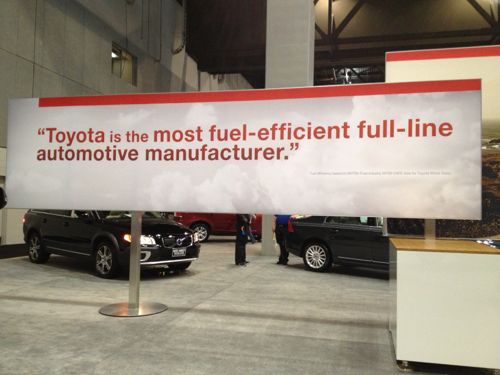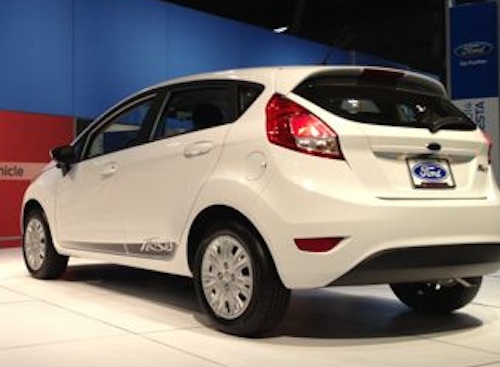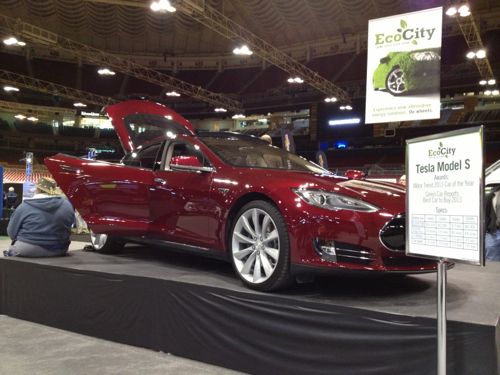The 2013 St. Louis Auto Show
Fuel economy is mentioned often in this year’s St. Louis Auto Show, which started yesterday and runs through 5pm Sunday.

No wonder really, given the views of today’s auto buyers:
15% of those surveyed said that fuel economy was their #1 criteria in choosing a new car, but as low as that figure sounds, it still outranked styling, reliability, and cost. In other words: fuel economy is leading the pack, but not by much. (Christian Science Monitor)
Consider where we were in 2008:
The cost of gas in June of 2008, the early stages of the heavy summer driving season and during the presidential campaign, was $4.10 per gallon. The 2008 gas crisis hit its peak one month later with prices averaging $4.11 per gallon. (CBS News/Face the Nation)
By December 2008:
Gas prices declined for the sixth straight day on Thursday, falling below the $1.65 per gallon, according to a national survey of credit card swipes at gasoline stations. (CNN Money)
Currently the national average is around $3.31/gal (AAA).
This focus on fuel economy is partly a response to consumer demand but also to higher standards announced by the Obama Administration in August 2012:
The standards — which mandate an average fuel economy of 54.5 miles per gallon for the 2025 model year — will increase the pressure on auto manufacturers to step up development of electrified vehicles as well as sharply improve the mileage of their mass-market models through techniques like more efficient engines and lighter car bodies.
Current rules for the Corporate Average Fuel Economy, or CAFE, program mandate an average of about 29 miles per gallon, with gradual increases to 35.5 m.p.g. by 2016. (NY Times)
I’m glad to see manufacturers and consumers on the same page.



The annual show is billed as the “largest automobile event in the St. Louis area, the 2013 Saint Louis Auto Show features more than 500 new cars, trucks, SUVs and luxury vehicles from over 25 manufacturers all under one roof.” Maybe, but some weren’t present: Mercedes-Benz, Land Rover, BMW, and Porsche.
Still, the show is a great place to see many cars in one place. It runs noon-10pm today, 10am-10pm Saturday, and 10am-5pm Sunday.
— Steve Patterson
I agree, fuel efficiency is important to many consumers. How do you reconcile these gains with the headline in today’s Post-Dispatch, “Sales tax hike proposed for Missouri highways while senators weigh income tax cuts”? As a non-car-owner, do you think it makes sense to shift revenue for highways from a dedicated source (fuel tax) to one paid by everyone (sales tax) and one that would have no correlation to miles driven?
I think you know my answer already, Missouri has one of the lowest gas taxes in the country. That’s the place to raise the money to pay for roads.
Low gas tax, high gas tax. It doesn’t really matter. Road and transportation interests aggressively stopped the “diversion” of gas taxes to other sources years ago. Since then, gasoline is held in such special esteem in that — unlike every other retail product — its purchase contributes nothing to general sales tax revenue. I say, fine, you want to “stop the diversion,” then let every road – from the federal interstate highway system down to local roads, pay for themselves via gas or other direct user tax.
Your groceries aren’t being delivered to Schnucks on a bus. Everyone — whether directly or indirectly — uses our road network.
You are correct, sir! However, it’s not as simple as everyone uses so everyone should pay. You can either take the a la carte path or you can take the all-you-can-eat buffet path. There are three major components in highway budgets, maintenance, repair/replacement and expansion projects. Maintenance, things like repaving and snow removal, should come from general funds. The need for repair or replacement is caused mostly by heavier vehicles and should be borne by the vehicles causing the damage (large trucks). And the “need” for expansion (adding lanes and building new roads) comes primarily from sprawl and supporting greenfield developments and that should be borne by the developers and occupants of the new projects.
General funds are mostly generated from income, sales and property taxes. Targeted funds are mostly generated from user fees, things like gas taxes, impact fees, permit fees and tap fees. I have a short, 5 mile, 15 minute, drive to work every day, and none of it involves a freeway. Some of my coworkers drive an hour or more each way, using the metro freeway system. I fill up my tank every 3 weeks or so, they do it way more frequently, so they’re also paying more than I do to support highways. The question now becomes one of “fairness” – is it more fair to pay for what you use or is it more fair for each of us to pay (closer to) the same to get to work every day? Switching to sales taxes to fund highways would shift the equation from the former to the latter. Personally, I’m a big believer in choices. You don’t have a lot of choices in where you work, but you do have a lot of choices in where you live (and I shouldn’t be supporting your choices at the expense of mine).
Similarly, building the Page Avenue Extension (364), converting Highway 94 and US 40 into freeways in St Charles County, rebuilding and extending Highway 141 in St. Louis and Jefferson Counties and four-laneing Highway 100 between I-44 and Washington, MO, to name just a few projects, serve ONLY to support sprawl and to encourage more people to commute longer distances to decentralized employment opportunities! Why should I be expected to support these (poor?) choices? Especially if I rarely go out that way (and never at rush hour – two lanes would be fine for me)?
Finally, infrastructure for interstate trucking should be the responsibility of the federal government. They paid 90% of the cost build the interstate system, they should pay 90% of the cost to rebuild it! The only sales taxes we’ll see from most interstate truckers will be sales taxes on truck stop meals. I’d much rather see them pay their share thru taxes on diesel fuel. It should make for an interesting discussion . . . .
I don’t use ambulance or fire services, but I’m happy to pay for it.
You haven’t used ambulance or fire services YET. When you need it, you will expect it to be there for you.
You don’t use them every day, so the cost of providing your share of the services is tiny, as it should be. You probably wouldn’t even object to paying several hundred dollars (the true cost) of using a private ambulance in an emergency. But if it were something you needed every day or week, you’d be a LOT more price sensitive. The metric for discussing highways is a lane mile. The number of lane miles being built in the region is continuing to increase, as is the need to maintain and, ultimately, replace each and every one of them. Vehicle miles traveled (VMT’s) are increasing faster than the region’s population. The real question is do we really want to become more like southern California, Atlanta or Houston? Or, do we want to become more like Portland, San Francisco or Manhattan?
If the cost of transportation is subsidized from eight different directions, there is no incentive to improve transportation. If you allocate the costs of transportation to the companies that provide transport, then sure, cost of goods will rise in proportion to the decline in subsidy. But there is that much more pressure to improve the way groceries (or anything) get transported – how far, how efficiently, and which modes.
As JZ points out, you as a consumer can directly control your costs; for example, if food shipped from California becomes too expensive, you might make a smart economic decision and buy food from closer to home, or food shipped through more efficient means that has a competitive advantage.
Subsidizing shipping the way we do is a form of moral hazard, and nobody wins.
Everyone does use the road network. They just don’t think so and they want everyone else to pay for it. The greater good is no longer viable option…it’s all about the greater me. Pathetic really.
Some people use the road network a lot more than others. Some damage the road network a lot more than others. I believe in the greater good, I expect to pay for my fair share. I also expect growth / sprawl to pay for itself, not to be subsidized at the expense of dense, urban areas. One big reason, among many, that the city struggles with declining revenues and a stagnant population is that it has become very easy, if one so chooses, to commute in a single-occupant vehicle, dozens of miles each day, to live and/or work, far outside the city. I’m not saying that you shouldn’t have that choice, I’m asking what duty does the government have to make that choice more convenient, to make anyone’s commute quicker? To give them a 60 mph road to replace a 35 or 45 mph road? To build a new bridge over the Mississippi solely because of rush hour congestion? Public transit needs density to work effectively, and yes, it’s a form of coercion to spend money on better transit and toll roads while “ignoring” congested freeways and surface streets, but it is one big tool government has to shape how growth occurs. Building more lanes is a choice, as is congestion pricing, HOV lanes, HOT lanes and public transit. It gets back to that old chicken-or-egg conundrum – do better highways encourage sprawl or are they simply the best solution for providing mobility to areas where people are already moving? I’m in the camp of “You can’t pave your way out of congestion”.
Living and working in Saint Louis City is a car lovers dream. Very short commute, cheap petrol, plenty of parking, good traffic and police generally to busy to care about violations. When was the last time you (or anyone you know) received a ticket in the city for not signaling, speeding or rolling a stop sign?…never, that’s when! With limited LRT track (in the city limits) transit is only an option if you have huge amounts of time to ride the bus. I’d love to not require a car but in STL I would venture to say that most households would find it problematic at best.
Given how great the average millage is these days, even on pick-ups, I’d call fuel efficiency considerations primarily a burden of the suburban. For the person who lives and works in STL City, comfort, reliability, style, power, etc, generally all come before efficiency. Focus or Mustang isn’t going to make much difference at the pump when daily miles are single digits. Gives you the freedom to buy whatever you’d like!